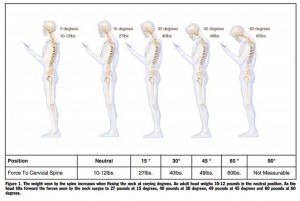Are you practicing safe text?
 Practicing safe text for the hours you spend in front of a hand held device?
Practicing safe text for the hours you spend in front of a hand held device?
Do you know which parts of your body you need to be aware of to change your posture and move more easily. Millennials, according to recent surveys could be setting themselves up for long term spinal damage experts say. A new poll reveals just how different Gen Y workers are from their Baby Boomer forefathers. Among other characteristics that stand out, millennials, who have come of age with the text message and social media, are an impatient bunch: They’re hyper-connected, tech savvy, entrepreneurial, and collaborative. It is turning out that staying connected has a physical downside when it comes to the body.
Gone are the days when pain in the neck was simply a figure of speech and an occasional reality. These days one of the largest daily threats to our necks and cervical spines is the head forward posture that chronically plagues us through the use of our hand held devices. Steve Dorfman, contributed to the Globe and Mail in December 2014 the following argument that colloquially termed “text neck,” the condition which is both caused, and exacerbated, by the undue stress we place on our necks while looking down at mobile devices… is no joke. Smart phones, tablets, e readers- they should all be embossed with warnings about the dangers of maintaining proper head posture.
In a neutral posture the head places around 12 lbs or 5 kilos of manageable stress on the cervical (neck) spine and gravity is not working against you. The curves found naturally in our vertebrae support the weight of your head when the body is doing a good job of being upright. However, according to a study by New York Orthopedic surgeon and author Dr. Kenneth Hansraj published in December 2014 issue of Surgical Technology International, tilting your neck just 15 degrees downward (about 2-3 inches or 5-7 centimeters) adds an additional 27 pounds of stress to your cervical spine. At 45 degrees, its 49 pounds; at 60 degrees 60 pounds. actor Dr. Dean Fishman, who created the Text Neck Institute to combat the problem, deems the condition “a global epidemic” and worldwide health concern.” Another Florida chiropractor Dr. David Rudnick says, “the extra stress created by suboptimal “anterior head carriage” creates a shearing of the vertebrae that leads to inflammation in the ligaments, soft tissue (muscle and tendon) and facet joints of the neck.”
“Overtime, he warns, the damage can progress from simple muscular pain and headaches to extensive osteoarthritis and/or herniated discs. The longer an individual is fixed in a forward head posture, the more complicated the syndrome becomes.” This condition has been found across the board from Boomers to elementary school kids but the highest risk demographic is the millenials.
Among other things, millennials (those in their 20’s and early 30’s) want flexible work schedules, more “me time” on the job, and nearly nonstop feedback and career advice from managers. Gen Y will also reshape the workplace—sooner than later, if they have their way.
Well, that means business for a Feldenkrais practitioner. Education is key here and understanding how the body works and is supported by the skeletal structure is matter of awareness and putting some new habits into place at home and at work. Join us for the first in a series of 3 Feldenkrais workshops developed by Roxanne Derkson Registered Massage Therapist and Guild Certified Feldenkrais Practitioner. The first in the series will address neck and shoulder pain, headaches and forward head posture. What you can do about them on a daily basis. Learn about yourself and your movements so you are not at the mercy of weekly therapy to keep you pain free. Avoid the long term effects of text neck now. Check out our class schedule here.